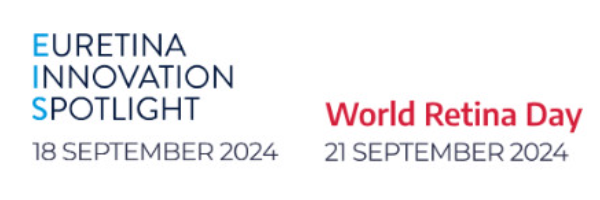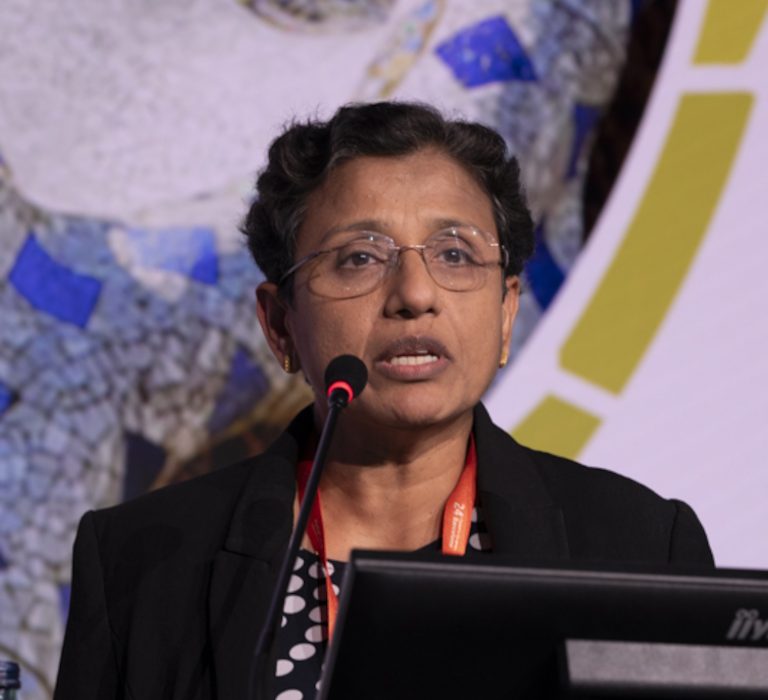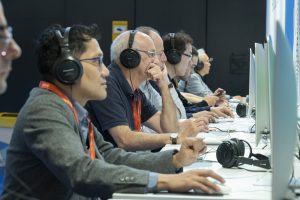Delegates filled the main auditorium to hear speakers at Euretina Session 1 discuss innovations targeting management of neovascular age-related macular degeneration (nAMD).
The programme began with Dr Sandrine Zweifel (Switzerland) speaking about OCT-based biomarkers for the disease. She provided an overview of what has been done in the past and options for the future. The remaining speakers focused on strategies for addressing the need to reduce the treatment burden for nAMD.
Dr Sobha Sivaprasad (United Kingdom) discussed bispecific treatment with faricimab and higher dose treatment using aflibercept 8 mg as options for increasing the durability of responses. She reviewed the phase 3 clinical trials supporting regulatory approval of faricimab and presented 1-year real-world outcomes achieved using this new option by the Moorfields Medical Retina Service. Dr Sivaprasad also reviewed the phase 3 study results for aflibercept 8 mg, which has just been approved in the United Kingdom.
She concluded, “We have sufficient robust clinical trial evidence showing these two agents are durable. However, we have no comparative data available between them and their trial protocols are very different. Therefore, real-world experience is essential.”
Continuing on the theme of reducing treatment burden for nAMD, Dr Nancy Holekamp (United States) reviewed the landscape of available and investigational sustained delivery strategies. As Dr Holekamp explained, the Port Delivery System with ranibizumab is the only approved drug delivery system for nAMD. Investigational approaches using solid drug delivery implants, intravitreal drug delivery implants, and suprachoroidal or subretinal drug delivery systems are at various stages in their clinical development programmes, and Dr Holekamp provided an overview of these products.
Dr Arshad M. Khanani (United States) provided an update on gene therapy for nAMD. He mentioned that ongoing gene therapy programmes are subretinal and suprachoroidal approaches for injecting RGX-314 as well as intravitreal treatment with ixoberogene soroparovec.
The main focus of Dr Khanani’s presentation was sharing first-time results of the longest available follow-up data for all cohorts from the PRISM Phase 1/2 study investigating 4D-150, which is an intravitreal genetic medicine designed to deliver a dual-transgene payload of aflibercept plus VEGF-C RNAi expression. In summary, Dr Khashani said that intravitreal 4D-150 reduced the intravitreal anti-VEGF treatment burden in pre-treated patients in both high need and broad need populations while providing sustained anatomic and functional control. The available evidence also showed the treatment was safe and well-tolerated. Now the development programme is moving forward into a phase 3 trial, he said.
The session concluded with Dr Timothy Jackson (United Kingdom) presenting results from a pivotal, non-commercial, randomised double-masked, sham-controlled trial investigating stereotactic radiotherapy (SRT) for treatment of chronic active nAMD. He reported that the study met its primary endpoint, showing that after 2 years, SRT reduced ranibizumab treatment burden, and it did so without compromising vision. Although patients treated with SRT had more microvascular abnormalities than the sham-treated control group, paradoxically those with these abnormalities tended to have better vision.
Dr Jackson concluded, “I want to stress these are results from 2 years, and we suggest waiting to get the 3- and 4-year results before we draw full conclusions.”
This session will be available to all registered attendees to view on the On Demand portal.
























































































































